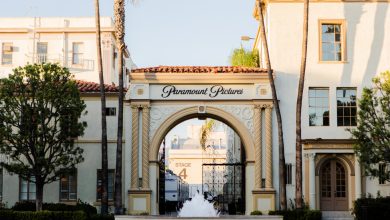In Venice, a Young Boatman Steers a Course of His Own

VENICE, Italy — From the time he was a child, Edoardo Beniamin could envision paddling a gondola through the waterways of Venice, his native city. He saw himself, dressed in a striped jersey and ribboned straw hat, following his father and an uncle into a profession that has served as the enduring symbol of La Serenissima for a thousand years.
“To be a gondolier was always my dream,” Mr. Beniamin, 22, said one bright winter day in a Venice rendered vacant by a wave of Covid-19 sweeping across Europe.
Seated at an outdoor cafe near the San Zaccaria waterbus station on the Grand Canal, Mr. Beniamin explained why his childhood imaginings had felt to him unrealistic. “In the gondola business, it matters a lot if you are the son of someone,” he said. “But I really didn’t think it could be possible, since girls could not do it.”
A slight man with a thatch of coppery hair and facial scruff, Mr. Beniamin was assigned female at birth. For the first 16 years of his life, he said — turning up the collar of his shearling jacket against the chill — he had not felt a need to call that into question.
“When I was very very young — let’s say, 6 or 7 — I wanted to be a man but it was more for fun,” he said. “I preferred boy’s clothes, for example, and I used to say these things — ‘I want to dress like a man’ — that were not serious. I thought I was a girl and so I forgot all about it.”
Five years ago, while still in high school and dating his girlfriend — Claudia Nardelli, now 22 and his fiancée — he experienced what some in the trans community term an “egg” moment, an emergence. He began questioning whether the crippling migraine headaches and related health complaints that plagued him, most notably after gym class — and that led his mother to take him from one doctor to another — had origins that were not neurological.
“Let’s say everything started from my health,” he said. “I was suffering and feeling bad with myself, but I didn’t know it was dysphoria: I didn’t even know the word existed. It was Claudia who opened my mind. She said, ‘Maybe something else is going on.’ And then, you know, gradually this thing happened that I found out I was a guy.”
In a sense Mr. Beniamin’s experience resembles that of many trans people, who for reasons that may be societal, cultural, legal or psychological — or all of those things combined — are often forced to confront a constellation of challenges when reconciling the divergence between the gender assigned them and who they truly are. In his case there was an additional hurdle. Mr. Beniamin had always assumed that entering his father’s profession was impossible.
It is not that there are no female gondoliers, although that’s how it was for 10 centuries. In 2010, Giorgia Boscolo became the first woman officially recognized by the Associazione Gondolieri di Venezia, or Venice Gondolier’s Association. Now, of the 433 licensed gondoliers at work in Venice, five are women, according to Andrea Balbi, the president of the gondolier’s association. There is, in addition, Alex Hai, a German-Algerian transgender woman who runs a private gondola service under the auspices of a hotel. “But she hasn’t passed the test,” Mr. Balbi said.
On Being Transgender in America
- Elite Sports: The case of the transgender swimmer Lia Thomas has stirred a debate about the nature of athleticism in women’s sports.
- Transgender Youth: A photographer documented the lives of transgender youth. She shared some thoughts on what she saw.
- Remote Work: Remote work during the pandemic offered some people an opportunity to move forward with a transition. They are now preparing to return to the office.
- Corporate World: What is it like to transition while working for Wall Street? A Goldman Sachs’ employee shares her experience.
That test is open to all, Mr. Balbi insisted. “Our job is for everyone — male, female, transgender, maybe some other kind of gender we don’t even know about,” he said. Yet breaking into this signature profession is not so simple.
Nicolo Casarin, 37, was well established as a boat captain on the city’s waterbus system when he finally passed the gondolier’s test on his fourth try. “I started when I was 19, and I got my license at 34,” Mr. Casarinsaid. “It’s super-hard to get in, almost impossible if there is not someone in your family in the business.”
The test, administered annually, entails much more than knowing how to master the art of balancing and rowing an asymmetrical 36-foot vessel through Venice’s 177 canals.
“There are many hours of art history, histories of the city, navigation, routes, foreign languages to learn in addition to Italian and Venetian dialect,” Mr. Casarin said. There is, too, boat maintenance and study of the tides and fickle winds along the Adriatic Sea.
Those things came easily enough to Mr. Beniamin, a byproduct of his upbringing around watercraft, a city kid’s easy familiarity with Venice’s six distinct districts, as well as a series of part-time high school gigs working as a tour guide. Although his comparatively small frame could be seen as an impediment to him as an oarsman, the toughest barrier he confronts as he begins training to enter the family business as the first openly transmasculine Venetian gondolier is also, in some ways, the least expected.
Since 2019, when he began hormone replacement therapy, Edoardo Beniamin’s outward appearance has increasingly conformed to conventional masculine ideals. Since December of last year, when he succeeded in petitioning the Italian bureaucracy to amend his birth certificate and other official documents to reflect his gender, he has been legally male.
“What happened next,” Mr. Beniamin said, “is that, once I figured out I was a male, I also realized I had always had a certain idea of what masculinity is. I thought that to be a man is to be a certain way. Now what I think about is different. What I ask myself all the time is, ‘What is a man?’”
In certain ways Venice is an ideal backdrop for his question. Insular, cryptic, ineffable in its appeal and yet riddled with cliché, the labyrinthine city is intricately mapped and yet, as any visitor knows, confounding to navigate. Masculinity can also be like that.
Before I encountered Edoardo Beniamin, at the office of his speech therapist, Eleonora Magnelli, in Florence in January, I had given little thought to what bearing the sounds produced when air passes over my vocal cords had on my identity. I took for granted that I sounded like a cisgender man — or, anyway, myself.
When Mr. Beniamin first contacted Ms. Magnelli, via Instagram, seeking information about a program to help transgender singers, his voice was, as she said, “very metallic, and it bothered him.” At the time there was little in the clinical literature about voice and gender stereotype. Many in her field assumed that taking testosterone and lowering vocal tones was sufficient to address the concerns of a transgender man.
“But pitch is not the only parameter,” Ms. Magnelli said. “And the training we do differs from other kinds of speech therapy, because clinicians must always remember that clients are not affected by any pathology. We are just helping them in affirming their identity.”
For Mr. Beniamin, the process of affirming himself through vocalization was as critical as some of the medical procedures underway to alter his physical appearance. “You need to talk a lot if you want to be a gondolier,” he said.
In fact, a gondolier’s palaver and (less often these days) crooning is a large part of what tourists expect when they pay $85 for a half-hour of being rowed along a preset route in a velvet-upholstered craft. “Changing my voice changed my life,” Mr. Beniamin said.
It is not just that strangers no longer call him madam. (“I don’t just want a deeper voice at the end of this journey,” he said.) Neither is it that Rambo, the Chihuahua he shares with fiancée, now obeys his commands after years of ostentatiously ignoring him.
“Obviously, it’s more than that,” Mr. Beniamin said. “What brings me euphoria is feeling people see me as I see me.”
On an unseasonably warm January day in Florence, I accompanied Mr. Beniamin on a visit to Dr. Giulia Lo Russo, an aesthetic surgeon with a subspecialty in performing chest masculinization, or so-called top, surgery on transgender men. A video Dr. Lo Russo brought up on an iPad illustrated how broad the range of results can be. “The point is not just to remove the breasts and reduce a female torso,” Dr. Lo Russo said. “You have to make a male torso.”
Asked to explain the difference, Dr. Lo Russo spoke instead about her therapist. “My psychologist asked me why I do these surgeries,” she said. “Why me? I’m not L.G.B.T.Q. But I am deeply anti-conformist. I have had three children with three different men.”
While we chatted, Mr. Beniamin casually prepared for his examination by stripping off a pullover sweater and T-shirt and unwinding the kinesiology tape he uses to bind his chest.
“The state doesn’t make it easy for people to get this surgery,” Dr. Lo Russo continued. “You have to wait one year for documents and, because of that, it’s hard to get on my schedule. I only do one top surgery a month, though with Edoardo, I put him on the roster a year in advance because it was clear to me that this was the right thing.”
In the end, she added, as she held up a smartphone to snap “before” photos of her patient, “people must be true to themselves.”
For Sara Mion, 51, Mr. Beniamin’s mother, Edoardo is now her son the apprentice gondolier, a guy with a future wife and plans to start a family after marriage. If for a long while she was reluctant to accept her son’s transition, she no longer has any such hesitation. “As a mother, I decided, ‘Do I lose her or do I try to understand him?’” she said.
Ms. Mion is a renal care nurse at a hospital in Venice and so it is somehow more poignant that the moment she accepted Edoardo as her son occurred when she administered one of his early testosterone injections. “I told him then, ‘I gave birth to you twice — the first time in the hospital and now again with this,’” she said.
Ms. Mion and I were sitting in the sun near one of Venice’s many (opinions vary, but the overall consensus is there are about 450) footbridges. Gondoliers gossiped nearby in clusters, awaiting the tourists that — uniquely in recent Venetian history — were nowhere to be found.
Ms. Mion and Mr. Beniamin’s father, Paolo, divorced when their two children were young. Their relationship since then has remained cordial, if distant — or as detached as any Venetian can hope to be in a city whose native population is small enough to see itself as endangered.
Paolo Beniamin’s gondola bobs in a prime berth along the Grand Canal, just outside the water gates of the luxurious Hotel Danieli. Ms. Mion said she finds it reassuring to know that, when the time comes for Edoardo to join in the family business, he can rely on his father as a cicerone.
Things were not always like that, as Edoardo Beniamin explained one day on a gondola piloted by Mr. Casarin. “My dad tried to push the reality away for a long time,” he said as Mr. Casarin propelled us through a series of especially narrow canals, or rii. “He didn’t want to use the pronouns,” Mr. Beniamin said, referring to his preferred “he” and “him.” “But then, the last time we talked, my dad said to call him when it was time for my top surgery and he would drive me to the hospital.”
Venice that day was eerily tranquil, as at various times since the start of the pandemic, and this must also have been true during the great plague that permanently altered its history as a great world power. The lagoon’s bottle-green surface remained relatively placid as wavelets hit the gondola’s glossy hull with lulling slaps.
Suddenly, a chevron of Italian Air Force jets blasted across the horizon toward the city, arcing through the sky above the St. Mark’s Square and the Doge’s Palace and leaving behind a trail of tricolor plumes. The mysterious aerial acrobatics continued for the next 20 minutes as jets zoomed in and out of view, the din from their turbines making it difficult to be heard.
Then, as abruptly as they had appeared, the aircraft tipped upward and vanished into the ether. That was when Mr. Beniamin noted how it seemed as if downdraft from the flyover had disturbed the water’s surface, jostling the iron prows of vessels at mooring.
“Gondolas are basically flat at the bottom,” he said. “It’s an interesting thing to know about them, that it takes very little disturbance to rock the boat.”




